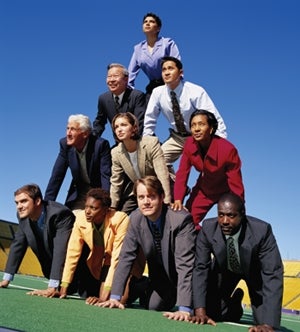Knowhow: Teambuilding

If you’ve asked yourself how you can become a better leader, you’re not alone. Oftentimes, managers are promoted because they excel at certain tasks. But they’re often untested — and untrained — when it comes to leading a group of people.
So how do you get a group of people to work together?
Strength In Numbers
What is the definition of a group? One basic definition is that a group is a collection of people working together for a common goal. Whether you are an owner of a small business or a manager for a large business, you have a group of people working for you and working toward some common goal or goals.
Typically, managers focus on job descriptions or budgets or last month’s sales performance, or in other words, common goals. We are all pretty good at developing goals and objectives. But how many of us really focus on the people in our groups?
Building is the creation and construction of a product. If we take our definition of a group and combine it with the act of building, we get a construction of people working together toward common goals. And therein lies the heart of the matter: Construction of people. Good managers and team leaders understand that they are building their people.
As a leader of a group, teambuilding is the single most important focus you need to have. But teambuilding shouldn’t just be considered an afternoon at the ballpark. Those are great vehicles to continue the process, but they aren’t an end in themselves. Rome wasn’t built in a day and the same is true of your group at work. Teambuilding programs should be employed as frequently as possible. Effective programs will give the people in your group a chance to work on their individual and group relationships and to understand and enhance their group’s identity.
How can we become better leaders? Answering that question starts with knowing your people and letting them know each other. People will go the extra mile for someone they care about.
Now that you understand the value of building your people, here are some tools to help you with your teambuilding.
Get “in the water.” Sea World trainers create and deliver their shows by communicating and training killer whales. The trainers use a simple but effective process and it starts by getting in the water. The trainers use positive reinforcement with the whales. When a whale does something that the trainers want, it is rewarded and that act is reinforced. They are not yelling at the whale for failing. Be proactive with your team and get wet.
Experiential learning. We learn more effectively through participation in an activity. We only remember a smaller percentage of a topic if we are told or read something. The percentage increases tremendously the more involved we get.
Have fun. A typical adult who faces a puddle in his/her path will walk around it and maybe even complain about the puddle being in their way. A typical 7-year-old will jump right in that puddle. Have fun and don’t worry about laundry or what other people are thinking. We need to jump into the puddle more as adults and as leaders.
Be patient. Teambuilding is a process — you need to start it and stay disciplined. If I want to lose 20 pounds it isn’t going to happen until I create a game plan and stick with it — I need to eat better and exercise. The same concept holds true with your team at work. Create your group's blueprint and stay disciplined every day.
Bob Rojee is a regional manager at Teamworks, which has Central Massachusetts location in Northborough, Acton and Auburn. He can be reached at brojee@twcenters.com.









0 Comments